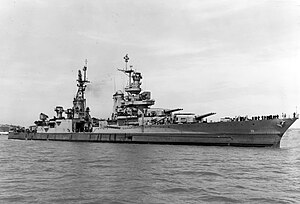
Back Тежки крайцери тип „Портланд“ Bulgarian Třída Portland Czech Portland-Klasse (1933) German Clase Portland Spanish ناو کلاس پورتلند Persian Portland-luokka Finnish Classe Portland French Classe Portland Italian ポートランド級重巡洋艦 Japanese Portlandklasse Dutch
 USS Indianapolis (CA-35) off the Mare Island Naval Shipyard on 10 July 1945
| |
| Class overview | |
|---|---|
| Name | Portland class |
| Builders | |
| Operators | |
| Preceded by | Northampton class |
| Succeeded by | New Orleans class |
| Planned | 5 |
| Completed | 2 |
| Lost | 1 |
| Retired | 1 |
| Preserved | 0 |
| General characteristics | |
| Type | Heavy cruiser |
| Displacement | 9,950–9,800 long tons (10,110–9,960 t) |
| Length | |
| Beam | 66 ft 3 in (20.19 m) |
| Draft | 21 ft (6.4 m) (mean); 23 ft (7.0 m) (maximum) |
| Propulsion |
|
| Speed | 32.7 kn (37.6 mph; 60.6 km/h) |
| Range | 13,000 nmi (14,960 mi; 24,080 km) at 15 kn (17 mph; 28 km/h) |
| Capacity | Fuel oil: 1,500 tons |
| Complement | 807 (peacetime) |
| Armament |
|
| Armor |
|
| Aircraft carried | 3 × SOC Seagull scout-observation seaplanes |
| Aviation facilities | 2 × catapults |
The Portland class of heavy cruisers was a class of ships designed and constructed by the United States Navy in 1930. The two ships of the class, Portland and Indianapolis, saw extensive service during the Pacific War in World War II.
Designed as a modification over the previous Northampton-class cruiser, the Portland class displaced just under 10,000 long tons (10,000 t) and featured heavier armor and armament than previous cruisers. Featuring 8"/55 caliber guns and designed to function as fleet flagships, the Portland class were intended to fix problems with armament and armor that had been a weakness of preceding U.S. cruisers. These designs were carried over to the following New Orleans class, to which six intended Portland cruisers were converted, three of which were already mid-construction.
Portland served in many engagements including the Battle of Coral Sea, the Battle of Midway and the Guadalcanal Campaign, where she was severely damaged but nonetheless able to return to service. She later fought in the Battle of Leyte Gulf and the Battle of Okinawa. Indianapolis served as a fleet flagship for much of the war and fought in the Battle of Philippine Sea and the Battle of Iwo Jima. On 30 July 1945, after transporting components for the nuclear weapons Little Boy and Fat Man from the United States, she was torpedoed by the Japanese submarine I-58. Due to a series of errors and miscommunications her loss was not discovered for several days, and only 316 of her 1,195 crew survived – the greatest single loss of life at sea, from a single ship, in the history of the U.S. Navy.
© MMXXIII Rich X Search. We shall prevail. All rights reserved. Rich X Search